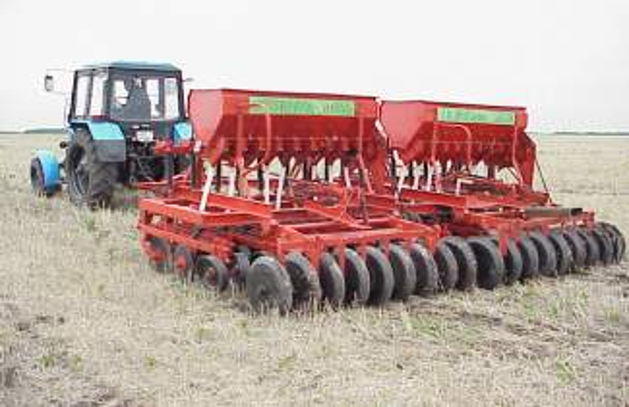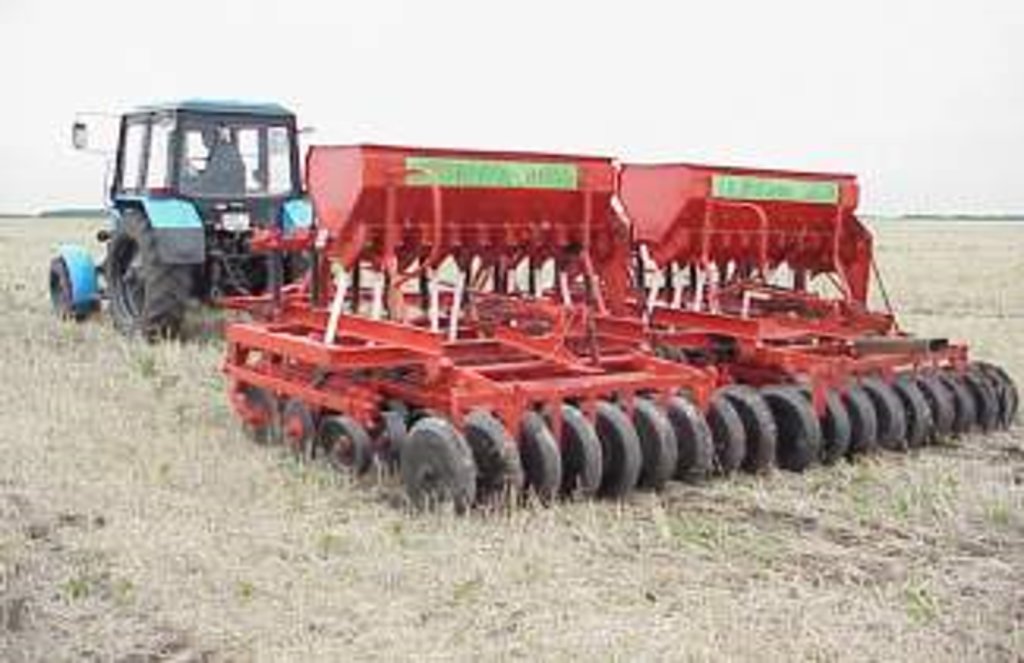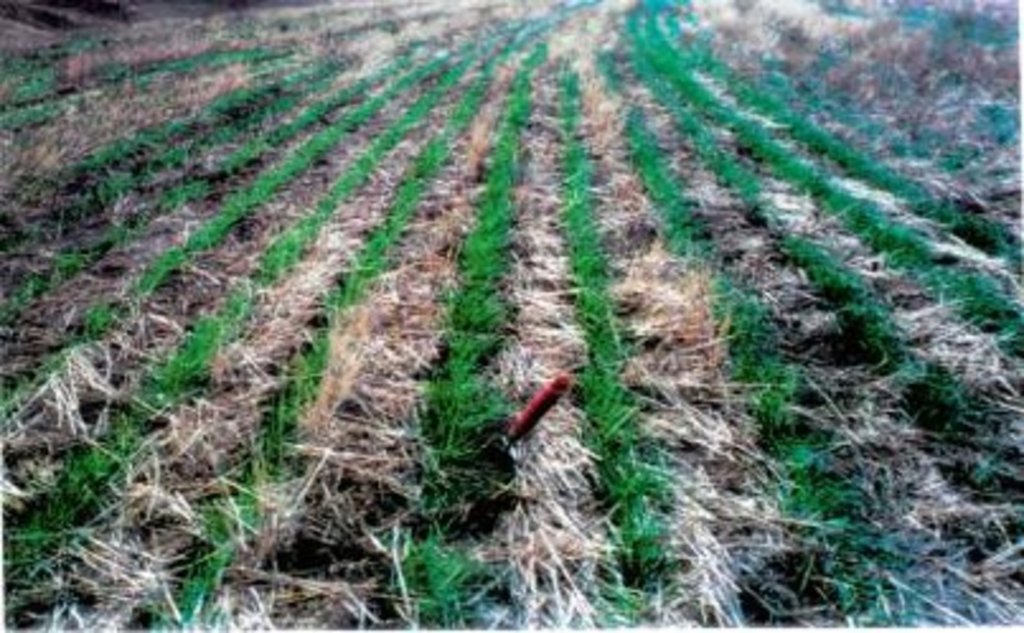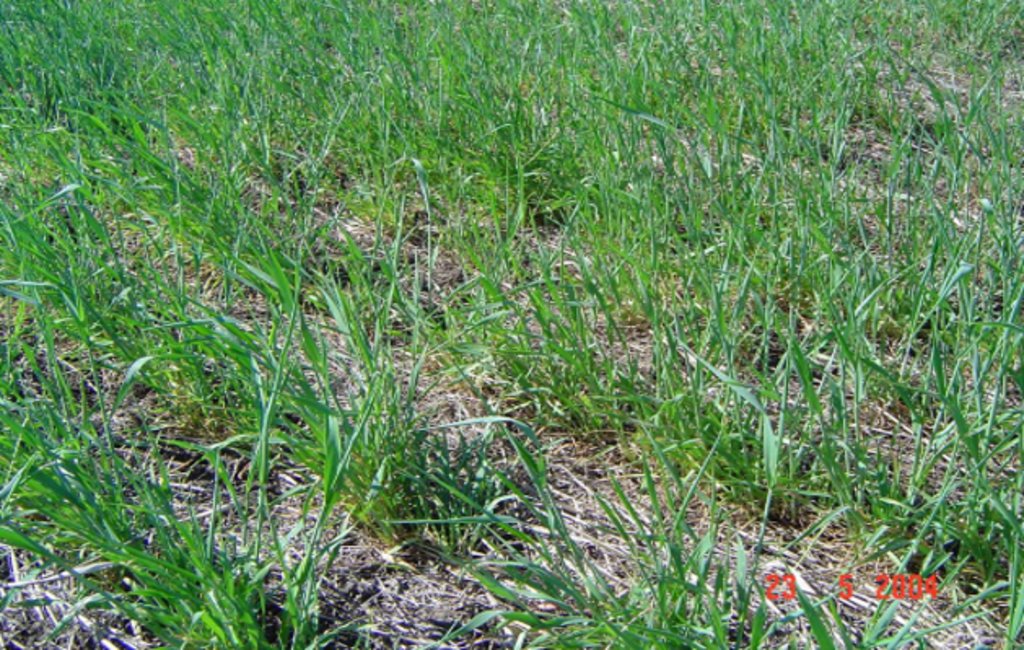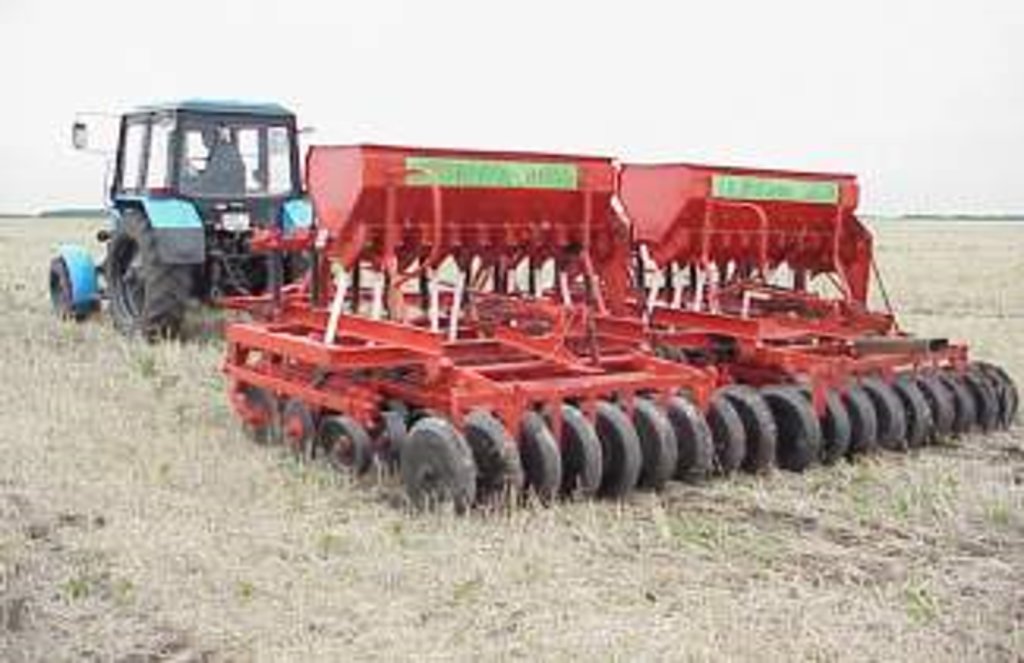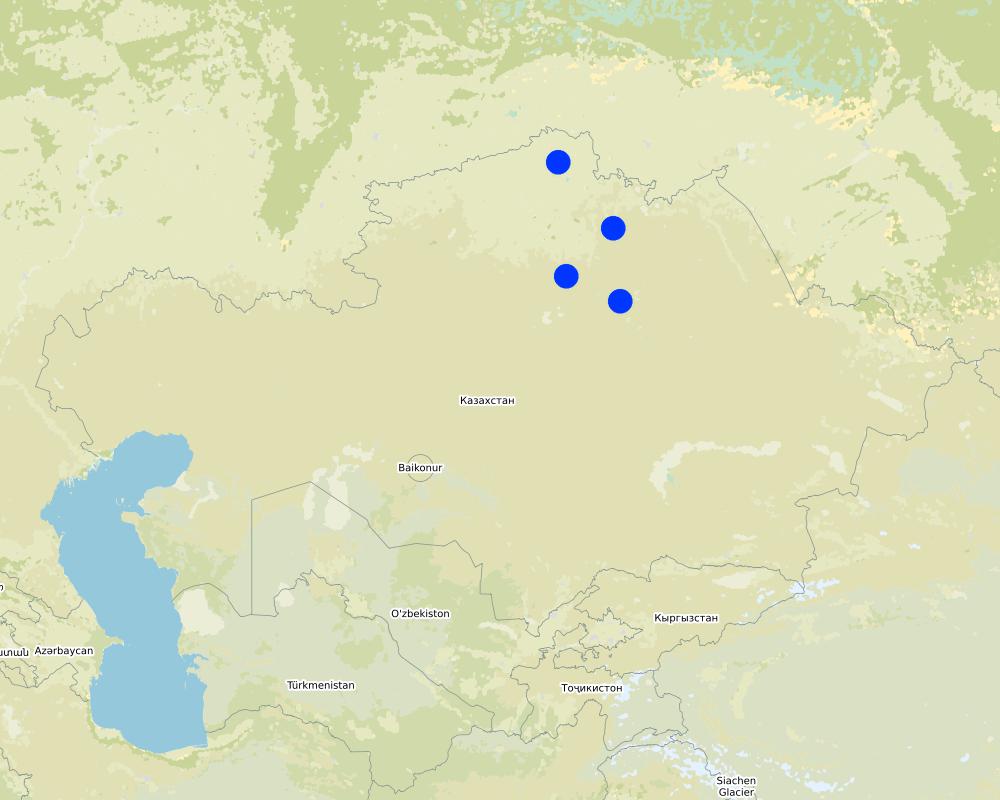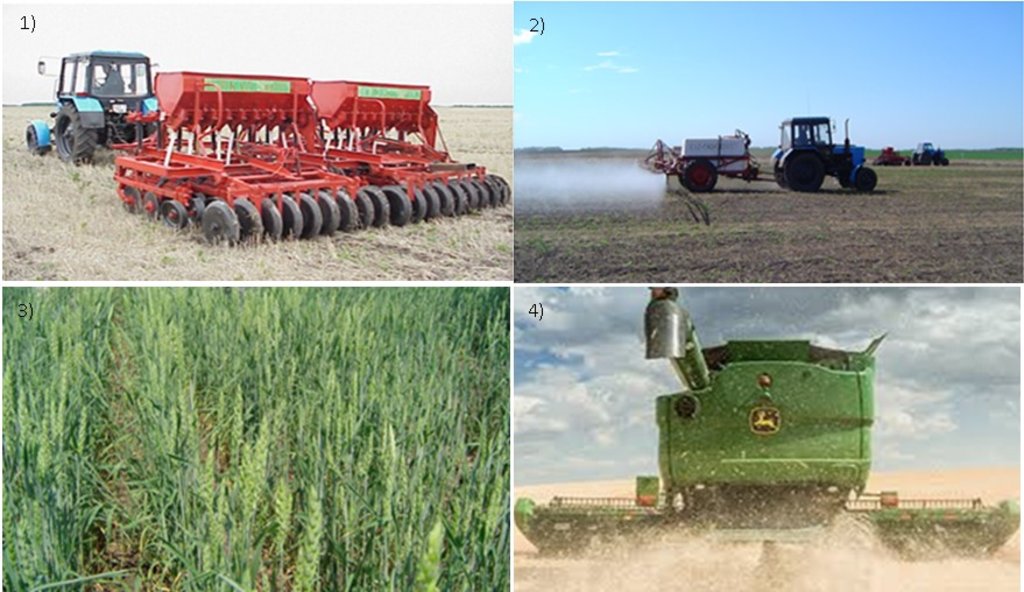Conservation Agriculture for cereal production in rainfed areas of Kazakhstan [Kazakhstan]
- Creation:
- Update:
- Compiler: Kulyash Iskandarova
- Editor: –
- Reviewer: Rima Mekdaschi Studer
Conservation Agriculture for cereals production in rainfed agriculture lands
technologies_5673 - Kazakhstan
View sections
Expand all Collapse all1. General information
1.2 Contact details of resource persons and institutions involved in the assessment and documentation of the Technology
Key resource person(s)
Expert/Consultant:
Karabayev Muratbek
CIMMYT-Kazakhstan
Kazakhstan
Name of project which facilitated the documentation/ evaluation of the Technology (if relevant)
Integrated natural resources management in drought-prone and salt-affected agricultural production landscapes in Central Asia and Turkey ((CACILM-2))Name of the institution(s) which facilitated the documentation/ evaluation of the Technology (if relevant)
Kazakh Research Institute for Livestock and Fodder Production (Kazakh Research Institute for Livestock and Fodder Production) - Kazakhstan1.3 Conditions regarding the use of data documented through WOCAT
The compiler and key resource person(s) accept the conditions regarding the use of data documented through WOCAT:
Yes
1.4 Declaration on sustainability of the described Technology
Is the Technology described here problematic with regard to land degradation, so that it cannot be declared a sustainable land management technology?
No
Comments:
The technology helps to restore degraded land
1.5 Reference to Questionnaire(s) on SLM Approaches (documented using WOCAT)
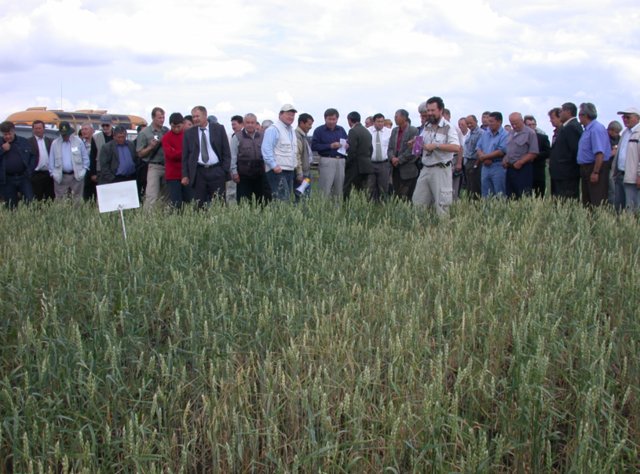
Awareness Raising for SLM Using Conservation Agriculture [Kazakhstan]
Raising awareness and strengthening the capability and skills of farmers, agriculture specialists and researchers in developing and adoption resource-saving, profitable and environmentally friendly cereal production through Conservation Agriculture practices.
- Compiler: Kulyash Iskandarova
2. Description of the SLM Technology
2.1 Short description of the Technology
Definition of the Technology:
Conservation agriculture applied in Northern Kazakhstan is based on no-tillage direct sowing of cereals into the soil permanently covered by crop residues. It contributes to reverse soil degradation, enhance water use efficiency, increase crop productivity in the rainfed lands.
2.2 Detailed description of the Technology
Description:
The cropping system in Northern Kazakhstan is based mainly on continuous wheat production using conventional technologies. Negative components of this system are intensive tillage, returning little organic matter to the land and monoculture. This system has led to soil degradation (wind and water erosion), soil fertility loss, boost-up of diseases, weed infestation and other problems.
Conservation Agriculture (CA) involves removing these negative components of conventional farming systems and includes three basic principles: 1) minimal soil disturbance, 2) permanent soil cover with crop residues and 3) crop rotation.
In accordance with these principles,
Conservation Agriculture technology includes 3 main operations:
1. Sowing with simultaneously soil fertilization using direct seeder.
2. Post-sowing (after 1-2 days) treatment by non-selective herbicide
3. Harvesting combined with simultaneous plant residues chopping and spreading
For comparison Conventional technology includes 7 operations:
1. Deep fall soil tillage (25 cm).
2. Early spring soil treatment.
4. Pre-sowing soil treatment.
5. Sowing with simultaneously soil fertilization using conventional seeder.
6. Selective herbicide application 2,4-Dichlorophenoxyacetic acid (2-4-D).
7. Harvesting.
The CA technology was applied in four farms in Akmola and North-Kazakhstan oblasts:
1.Farm “DARYN”, village Valikhanovo, Zharkainsky rayon, Akmola oblast, Kazakhstan.
2.Farm “Surayev”, village Vishnevka, Arshalinsky rayon, Akmola oblast, Kazakhstan.
3.Farm “Dostyk”, village Astrahanovka, Arshalinsky rayon, Akmola oblast, Kazakhstan.
4. Farm “Cherezdanov”, village Smirnovo, Akkayinskii rayon, Northern Kazakhstan oblast, Kazakhstan.
Depending on the capability of these four farms in total 330 ha agricultural land were allocated for the testing and adaptation of the technology. On each farm, field trials under equal conditions (soil, temperature, humidity, landscape, etc.) were conducted and included 2 treatments: Conventional (7 operations) and Conservation Agriculture (3 operations).
Analysis of 2002-2004 trials data demonstrated that yield of wheat and other cereals under CA technology was in average 15-25% higher in comparison with the conventional technology. The advantages of CA technology are especially evident in the years of drought (up to 40% in dry 2004 year). Economic evaluation of the technology made by two independent experts from Kazakhstan (Kazakh Research Institute for Grain Farming) and USA (Idaho State University) suggested that costs of labor, fuel, repairs and spare parts as well as machinery and equipment wearing-out under the Conservation Agriculture technologies is significantly lower as compared to those of traditional technology. In general, it is important to emphasize that the experience of the CA adaptation in North Kazakhstan helped farmers/land-users:
•To determine the appropriate level of tillage in a cropping system that is feasible with direct sowing and CA technology requirements as a potential goal.
•To retain sufficient residue on the soil surface to reduce soil erosion, enhance crop/water productivity, improve soil fertility (because of plant organic material bioprocessing in the soil) and better ensure long term, sustainable production.
•Employ economically viable, diversified crop rotations that can improve cropping system productivity and offer farmers new options to reduce risk that is extremely important for the conditions of Northern Kazakhstan relating to the area of risk farming.
The introduction of the technology for cereal production in the rainfed areas of Kazakhstan was realized within the framework of the FAO/TCP/KAZ/2801 (T) Project “Conservation Agriculture for Sustainable Crop Production in Northern Kazakhstan”, under active cooperation with counterparts: Ministry of Agriculture of the Republic of Kazakhstan (MoA RK), FAO, CIMMYT, Union of Farmers of Kazakhstan (UFK), national agriculture research organizations.
2.3 Photos of the Technology
2.4 Videos of the Technology
Comments, short description:
not available
2.5 Country/ region/ locations where the Technology has been applied and which are covered by this assessment
Country:
Kazakhstan
Region/ State/ Province:
Northern Kazakhstan: Akmola and North Kazakhstan regions (provinces)
Further specification of location:
Smirnovo village, Akkayin district, Northern Kazakhstan region; Valikhanovo village, Zharkainsk district, Akmola region; Astrahanovka village, Astrahanskyi district, Akmola region; 4) Vishnevka village, Arshalinsky district, Akmola region
Specify the spread of the Technology:
- evenly spread over an area
Is/are the technology site(s) located in a permanently protected area?
No
Comments:
1) Farm “Cherezdanov”, Smirnovo village, Akkayin district, Northern Kazakhstan region, located approximately 60 kilometers south of Petropavlovsk and 700 km from Astana (Nur-Sultan). The farm Head is Vyacheslav Cherezdanov.
2) Farm “Daryn”, Valikhanovo village, Zharkainsk district, Akmola region, located approximately 600 kilometers southwest of Astana (Nur-Sultan). The Head is Auezkhan Darynov.
3) Farm “Dostyk 06”, Astrahanovka village, Astrahanskyi district, Akmola region, located approximately 110 kilometers west of Astana (Nur-Sultan). The Head is Meyram Sagimbayev.
4) Farm “Surayev”, Vishnevka village, Arshalinsky district, Akmola region, located approximately 60 kilometers south of Astana (Nur-Sultan). The Head is Viktor Surayev.
Map
×2.6 Date of implementation
Indicate year of implementation:
2002
2.7 Introduction of the Technology
Specify how the Technology was introduced:
- through projects/ external interventions
Comments (type of project, etc.):
FAO TCP/KAZ/2801 (T) Project “Conservation Agriculture for Sustainable Crop Production in Northern Kazakhstan”
The project was initiated by UN Food and Agricultural Organization (FAO) under active cooperation with counterparts: Ministry of Agriculture of the Republic of Kazakhstan (MoA RK), FAO, CIMMYT, Union of Farmers of Kazakhstan (UFK), national agriculture research organizations. The project was aimed to testing, adaptation and introduction of Conservation Agriculture technology for cereal production in Northern Kazakhstan. At the present time the technology is applied on the area of around 3 mln ha in Northern Kazakhstan.
3. Classification of the SLM Technology
3.1 Main purpose(s) of the Technology
- improve production
- reduce, prevent, restore land degradation
- preserve/ improve biodiversity
- adapt to climate change/ extremes and its impacts
- create beneficial economic impact
3.2 Current land use type(s) where the Technology is applied
Land use mixed within the same land unit:
No

Cropland
- Annual cropping
Annual cropping - Specify crops:
- cereals - barley
- cereals - oats
- cereals - rye
- cereals - wheat (spring)
Number of growing seasons per year:
- 1
Is intercropping practiced?
No
Is crop rotation practiced?
Yes
If yes, specify:
Crop rotations at the project farms.
(In average, spring wheat occupies 50% of lands in crop rotations)
Plot/ field1st year2nd year3rd year
#1 Wheat Barley Wheat
#2 Rye Wheat Oat
#3 Wheat Oat Wheat
#4 Barley Wheat Rye
3.3 Has land use changed due to the implementation of the Technology?
Has land use changed due to the implementation of the Technology?
- No (Continue with question 3.4)
Land use mixed within the same land unit:
No
3.4 Water supply
Water supply for the land on which the Technology is applied:
- rainfed
Comments:
average annual rainfall: 250 mm
3.5 SLM group to which the Technology belongs
- improved ground/ vegetation cover
- minimal soil disturbance
3.6 SLM measures comprising the Technology

agronomic measures
- A2: Organic matter/ soil fertility
- A3: Soil surface treatment
- A6: Residue management
A3: Differentiate tillage systems:
A 3.1: No tillage
A6: Specify residue management:
A 6.4: retained
Comments:
CA technology implies retention plant residues (chopped and spread) in the field. This is organic matter in huge quantities. Due to biological processing of this substance the soil fertility as well as soil quality are improved.
3.7 Main types of land degradation addressed by the Technology

soil erosion by water
- Wt: loss of topsoil/ surface erosion

soil erosion by wind
- Et: loss of topsoil

physical soil deterioration
- Pc: compaction

other
Specify:
loss of soil fertility due to wind and water erosion
3.8 Prevention, reduction, or restoration of land degradation
Specify the goal of the Technology with regard to land degradation:
- reduce land degradation
4. Technical specifications, implementation activities, inputs, and costs
4.1 Technical drawing of the Technology
Technical specifications (related to technical drawing):
Sequence of main operations and elements of the technology implemented:
1) Direct sowing of wheat with seeder SZS 6.12 equipped with brazil disk openers and cutting discs, and simultaneous ammophos application at the rate of Р20
2) Herbicide treatment (Glyphosate 360) with sprayer OP-2000, 3.0 l/ha after wheat planting
3) Direct sowing spring wheat
4) Harvesting with chopping and overspreading of the straw
Technical specifications, dimensions, spacing of the experimental plots:
The total land area under the technology - 330 ha for 4 farms: «Cherezdanov», «Dostyk 06», «Suraev», «Daryn» (20 plots , 16.5 ha each)
1 plot - 16.5 ha (length - 702 m, width - 235 m)
Species used: wheat, barely, rye, oat. Different seed rates of spring wheat are used at the farms: from 105 kg/ha to 140 kg/ha.
Author:
Muratbek Karabayev
Date:
09/08/2004
4.2 General information regarding the calculation of inputs and costs
Specify how costs and inputs were calculated:
- per Technology area
Indicate size and area unit:
330 ha
Specify currency used for cost calculations:
- USD
Indicate average wage cost of hired labour per day:
22 USD
4.3 Establishment activities
| Activity | Timing (season) | |
|---|---|---|
| 1. | Snow Retention | Dec-Feb |
| 2. | Herbicides (Glyphosate) Application | May |
| 3. | Direct sowing, fertilizing | May |
| 4. | Herbicide Application | June |
| 5. | Harvest and Hauling | Aug-Sep |
Comments:
SNOW RETENTION: By leaving stubbles on the field to improve soil moisture storage.
HAULING: Farmers in Kazakhstan have to transport harvested yield to the special Grain storage/elevator, located distantly remotely, usually it is one elevator for one district. This is transportation expenses
4.4 Costs and inputs needed for establishment
| Specify input | Unit | Quantity | Costs per Unit | Total costs per input | % of costs borne by land users | |
|---|---|---|---|---|---|---|
| Labour | Permanent and seasonal workers | person-days | 242.7 | 22.0 | 5339.4 | |
| Equipment | Fuel | liter | 5374.28 | 0.35 | 1881.0 | |
| Equipment | Modification of seeders and sprayers | 2.0 | 1240.8 | 2481.6 | ||
| Equipment | Machinery Depreciation (7 Unit of equipment) | 7.0 | 1427.5 | 9992.5 | 100.0 | |
| Equipment | Machinery Interest (7 Unit of equipment) | 7.0 | 646.4 | 4524.8 | 100.0 | |
| Plant material | Wheat Seed | kg | 40764.7 | 0.17 | 6930.0 | |
| Fertilizers and biocides | Fertilizer: Ammonium Phosphate | kg | 33000.0 | 0.1 | 3300.0 | |
| Fertilizers and biocides | Herbicide: Broadleaf | liter | 330.0 | 5.5 | 1815.0 | |
| Fertilizers and biocides | Herbicide: Glyphosate | liter | 990.0 | 6.5 | 6435.0 | |
| Other | Land | ha | 330.0 | 12.88 | 4250.4 | 100.0 |
| Total costs for establishment of the Technology | 46949.7 | |||||
| Total costs for establishment of the Technology in USD | 46949.7 | |||||
If land user bore less than 100% of costs, indicate who covered the remaining costs:
The contribution from land users (4 Farms) were amounted to 18 767,7 USD. The remaining costs were covered by the funds of the project FAO / TCP / KAZ / 2801 (T) Project “Conservation Agriculture for Sustainable Crop Production in Northern Kazakhstan”
Comments:
- The "Labor" section provides the average data on the salary costs of permanent and seasonal workers
- Total costs for establishment of the Technology per 1 ha is 142,27 USD
- In general, the stage of establishment requires more expenses, in particular for acquiring a direct seeder or modifying the traditional one. In this case the additional expenses were made for modification of local seeders and sprayers.
4.5 Maintenance/ recurrent activities
| Activity | Timing/ frequency | |
|---|---|---|
| 1. | Snow Retention | Dec-Feb |
| 2. | Herbicides (Glyphosate) Application | May |
| 3. | Direct sowing, fertilizing | May |
| 4. | Herbicide Application | June |
| 5. | Harvest and Hauling | Aug-Sep |
4.6 Costs and inputs needed for maintenance/ recurrent activities (per year)
| Specify input | Unit | Quantity | Costs per Unit | Total costs per input | % of costs borne by land users | |
|---|---|---|---|---|---|---|
| Labour | Permanent and Seasonal Workers | person/days | 242.7 | 22.0 | 5339.4 | |
| Equipment | Fuel | liter | 5374.28 | 0.35 | 1881.0 | |
| Equipment | Equipment repairs and service | 2.0 | 1240.8 | 2481.6 | ||
| Equipment | Machinery Depreciation (7 Unit of equipment) | 7.0 | 1427.5 | 9992.5 | 100.0 | |
| Equipment | Machinery Interest (7 Unit of equipment) | 7.0 | 646.4 | 4524.8 | 100.0 | |
| Plant material | Wheat seads | kg | 40764.7 | 0.17 | 6930.0 | |
| Fertilizers and biocides | Fertilizer: Ammonium Phosphate | kg | 33000.0 | 0.1 | 3300.0 | |
| Fertilizers and biocides | Herbicide: Broadleaf | liter | 330.0 | 5.5 | 1815.0 | |
| Fertilizers and biocides | Herbicide: Glyphosate | liter | 825.0 | 6.5 | 5362.5 | |
| Other | Land | ha | 330.0 | 12.88 | 4250.4 | 100.0 |
| Total costs for maintenance of the Technology | 45877.2 | |||||
| Total costs for maintenance of the Technology in USD | 45877.2 | |||||
If land user bore less than 100% of costs, indicate who covered the remaining costs:
The contribution from land users (4 Farms) amounted to 18767.7 USD. The remaining costs were covered by the funds of the project FAO / TCP / KAZ / 2801 (T) Project “Conservation Agriculture for Sustainable Crop Production in Northern Kazakhstan”
Comments:
The "Labor" section provides the average data on the salary costs of permanent and seasonal workers.
Total costs for maintenance of the Technology per 1 ha is 139,0 USD
The totals of establishment and maintenance costs not the same due to the difference in the rate of use of the glyphosate herbicide (3 l/ha vs 2.5 l / ha)
4.7 Most important factors affecting the costs
Describe the most determinate factors affecting the costs:
CA technology shows some clear economic advantages compared to the traditional system. Production costs for CA are slightly higher, associated primarily with the cost of glyphosate. But they are partially reimbursed by lower costs fot labor, fuel and ownership costs associated with a slight reduction in equipment use. However, additional revenue associated with the higher yields experienced for CA compensates for the higher production costs.
5. Natural and human environment
5.1 Climate
Annual rainfall
- < 250 mm
- 251-500 mm
- 501-750 mm
- 751-1,000 mm
- 1,001-1,500 mm
- 1,501-2,000 mm
- 2,001-3,000 mm
- 3,001-4,000 mm
- > 4,000 mm
Specify average annual rainfall (if known), in mm:
250.00
Specifications/ comments on rainfall:
Short growing period, low rainfall during the growing period, frequent droughts, early and late frosts
Indicate the name of the reference meteorological station considered:
“KazHydroMet” National State Organization
Agro-climatic zone
- semi-arid
Farm “Cherezdanov”, Smirnovo village, Akkayinskii rayon, Northern Kazakhstan oblast: mean annual rainfall, mm - 333,4; mean annual temperature (degrees Celsius) - +1,6;
Farm “Dostyk 06”, Astrahanovka village, Astrahanskyi rayon, Akmola oblast: mean annual rainfall, mm - 319,6; mean annual temperature (degrees Celsius) - +1,6;
Farm “Surayev”, Arshalinsky rayon, Akmola oblast: mean annual rainfall, mm - 312,8; mean annual temperature (degrees Celsius) - +2,4;
Farm “Daryn”, Valikhanovo village, Zharkainsky rayon, Akmola oblast: mean annual rainfall, mm - 253,4; mean annual temperature (degrees Celsius) - +2,5
5.2 Topography
Slopes on average:
- flat (0-2%)
- gentle (3-5%)
- moderate (6-10%)
- rolling (11-15%)
- hilly (16-30%)
- steep (31-60%)
- very steep (>60%)
Landforms:
- plateau/plains
- ridges
- mountain slopes
- hill slopes
- footslopes
- valley floors
Altitudinal zone:
- 0-100 m a.s.l.
- 101-500 m a.s.l.
- 501-1,000 m a.s.l.
- 1,001-1,500 m a.s.l.
- 1,501-2,000 m a.s.l.
- 2,001-2,500 m a.s.l.
- 2,501-3,000 m a.s.l.
- 3,001-4,000 m a.s.l.
- > 4,000 m a.s.l.
Indicate if the Technology is specifically applied in:
- not relevant
5.3 Soils
Soil depth on average:
- very shallow (0-20 cm)
- shallow (21-50 cm)
- moderately deep (51-80 cm)
- deep (81-120 cm)
- very deep (> 120 cm)
Soil texture (topsoil):
- medium (loamy, silty)
Soil texture (> 20 cm below surface):
- medium (loamy, silty)
Topsoil organic matter:
- medium (1-3%)
If available, attach full soil description or specify the available information, e.g. soil type, soil PH/ acidity, Cation Exchange Capacity, nitrogen, salinity etc.
Soil depth on average: 1 m.
5.4 Water availability and quality
Ground water table:
5-50 m
Availability of surface water:
medium
Water quality (untreated):
poor drinking water (treatment required)
Water quality refers to:
both ground and surface water
Is water salinity a problem?
No
Is flooding of the area occurring?
No
5.5 Biodiversity
Species diversity:
- medium
Habitat diversity:
- medium
5.6 Characteristics of land users applying the Technology
Sedentary or nomadic:
- Sedentary
Market orientation of production system:
- mixed (subsistence/ commercial)
- commercial/ market
Off-farm income:
- less than 10% of all income
- 10-50% of all income
Relative level of wealth:
- average
Individuals or groups:
- employee (company, government)
Level of mechanization:
- mechanized/ motorized
Gender:
- women
- men
Age of land users:
- middle-aged
5.7 Average area of land used by land users applying the Technology
- < 0.5 ha
- 0.5-1 ha
- 1-2 ha
- 2-5 ha
- 5-15 ha
- 15-50 ha
- 50-100 ha
- 100-500 ha
- 500-1,000 ha
- 1,000-10,000 ha
- > 10,000 ha
Is this considered small-, medium- or large-scale (referring to local context)?
- medium-scale
5.8 Land ownership, land use rights, and water use rights
Land ownership:
- state
Land use rights:
- leased
Water use rights:
- communal (organized)
Are land use rights based on a traditional legal system?
Yes
Specify:
Land lease for 49 years
according to the Land code of the Republic of Kazakhstan
Comments:
Land ownership in Kazakhstan is on state and individual basis. Lands of large farms are owned by state, and farmers can use these lands only for farming purpose based on long-term agreement (rent) for up to 49 years with relevant state authorities and bodies. Smallholder farmers mostly owned agriculture lands (average size around 10 ha) individually.
5.9 Access to services and infrastructure
health:
- poor
- moderate
- good
education:
- poor
- moderate
- good
technical assistance:
- poor
- moderate
- good
employment (e.g. off-farm):
- poor
- moderate
- good
markets:
- poor
- moderate
- good
energy:
- poor
- moderate
- good
roads and transport:
- poor
- moderate
- good
drinking water and sanitation:
- poor
- moderate
- good
financial services:
- poor
- moderate
- good
6. Impacts and concluding statements
6.1 On-site impacts the Technology has shown
Socio-economic impacts
Production
crop production
risk of production failure
land management
Income and costs
expenses on agricultural inputs
farm income
workload
Socio-cultural impacts
food security/ self-sufficiency
SLM/ land degradation knowledge
Ecological impacts
Water cycle/ runoff
harvesting/ collection of water
surface runoff
evaporation
Soil
soil moisture
soil loss
soil crusting/ sealing
soil compaction
nutrient cycling/ recharge
soil organic matter/ below ground C
Biodiversity: vegetation, animals
beneficial species
Climate and disaster risk reduction
drought impacts
emission of carbon and greenhouse gases
6.2 Off-site impacts the Technology has shown
impact of greenhouse gases
6.3 Exposure and sensitivity of the Technology to gradual climate change and climate-related extremes/ disasters (as perceived by land users)
Gradual climate change
Gradual climate change
| Season | increase or decrease | How does the Technology cope with it? | |
|---|---|---|---|
| annual temperature | increase | well | |
| seasonal temperature | summer | increase | well |
| annual rainfall | decrease | well | |
| seasonal rainfall | summer | decrease | well |
Climate-related extremes (disasters)
Meteorological disasters
| How does the Technology cope with it? | |
|---|---|
| local rainstorm | well |
| local snowstorm | well |
| local sandstorm/ duststorm | well |
Climatological disasters
| How does the Technology cope with it? | |
|---|---|
| drought | well |
Hydrological disasters
| How does the Technology cope with it? | |
|---|---|
| flash flood | well |
6.4 Cost-benefit analysis
How do the benefits compare with the establishment costs (from land users’ perspective)?
Short-term returns:
neutral/ balanced
Long-term returns:
positive
How do the benefits compare with the maintenance/ recurrent costs (from land users' perspective)?
Short-term returns:
slightly positive
Long-term returns:
very positive
6.5 Adoption of the Technology
- 11-50%
If available, quantify (no. of households and/ or area covered):
about 3 mln ha under Conservation Agriculture in Kazakhstan now
Of all those who have adopted the Technology, how many did so spontaneously, i.e. without receiving any material incentives/ payments?
- 0-10%
Comments:
Kazakhstan is now included among the top ten countries with the largest areas under CA in the world (Source: FAOSTAT).
6.6 Adaptation
Has the Technology been modified recently to adapt to changing conditions?
No
6.7 Strengths/ advantages/ opportunities of the Technology
| Strengths/ advantages/ opportunities in the land user’s view |
|---|
| A special advantage of Conservation Agriculture is observed in extremely dry conditions. It allows to consider this technology as water-conserving, which is critical for risky farming area in Kazakhstan. |
| Conservation Agriculture is not inferior to traditional technologies and is competitive in the regional cereal production system and promising given their role in soil fertility recovery, cost reduction, increase in labor productivity and positive effect on the environment. |
| The wide-scale use of Conservation Agriculture in Kazakhstan, shift of farms to modern cropping systems are realistic and promising. |
| Strengths/ advantages/ opportunities in the compiler’s or other key resource person’s view |
|---|
| Based on the data on yield, ecological, soil and agronomic parameters and economic analysis, the Conservation Agriculture can be considered as effective and promising for the region. It will allow for farmers to switch to modern farming systems based on diversified crop production, minimal soil treatment, stubble retention, and direct seeding. |
| The modified local seeders, in general, performed well and can be used under production conditions. The possibility to locally produce direct seeders and well-established herbicide and fertilizer production suggest feasible wide-scale application of CA technology for crop production in the country. |
| Under current conditions, it is extremely important to intensify collaboration between national agricultural systems and international organizations and research centers. They actively use their large international expertise, modern technologies, rich genetic pool to facilitate a rapid integration of a country’s agrarian sector into the world system. |
6.8 Weaknesses/ disadvantages/ risks of the Technology and ways of overcoming them
| Weaknesses/ disadvantages/ risks in the land user’s view | How can they be overcome? |
|---|---|
| High costs at the 1st stage of technology implementation | State support programs or land user cooperation needed |
| Weed control problems | Weed control is one aspect that needs further research. Herbicides are costly in Kazakhstan, especially when compared to depressed grain prices. Options for weed control with different weed spectra and these different conditions must be available. One of the ways to combat is the crop rotation. Potential for more diversified systems in northern Kazakhstan exists. Policy emphasis should be placed on market development for alternative crops. |
| Weaknesses/ disadvantages/ risks in the compiler’s or other key resource person’s view | How can they be overcome? |
|---|---|
| Equipment availability for resource-poor farmers | There are many inexpensive models of direct seeders and other equipment for CA in the world market. Farmers need in marketing services, technical consultations. Subsidizing purchase of CA equipment by government can help farmers to advance the process of CA adoption in country and region. |
| Delayed effect (it takes time to get all the benefits of the technology) | Provision of long-term low interest loans |
| The problem of farmers' awareness of technology, its features and benefits | Awareness needs to be raised |
7. References and links
7.1 Methods/ sources of information
- field visits, field surveys
4 visits, field days
- interviews with land users
4 interviews with land users
- interviews with SLM specialists/ experts
2 experts
- compilation from reports and other existing documentation
When were the data compiled (in the field)?
2012
7.2 References to available publications
Title, author, year, ISBN:
1.Karabaev M., Vasko I., Matyushkov M., Bektemirov A., Kenzhebekov A., Bakhman T., Friedrich T., Makus L., Morgunov A., Darinov A., Sagimbaev M., Suraev V., Perezdanov V ., Rodionov A., Wall P. Zero-processing and direct sowing technologies for the cultivation of grain crops in Northern Kazakhstan. 2005. FAO-SIMMIT, 64 p. (in Russian)
Title, author, year, ISBN:
2.Shpigun S., Karabayev M.No-till and direct seeding technologies for cereals in North Kazakhstan. - Practical recommendations for farmers. Astana, Kazakhstan, 2007, 15 p.
Title, author, year, ISBN:
3.Karabayev M., Yuschenko N., Akramkhanov A., and Shpigun S.Forage crops production in dry areas with an allowance for ecological risks. - Methods of seeding and growing of perennial and annual grasses. Astana, Kazakhstan, 2007, 112 p.
Title, author, year, ISBN:
4.CIMMYT Wheat Improvement Program for Kazakhstan. Together in 21st Century. - 2008, CIMMYT, 56 p.
Title, author, year, ISBN:
5.Yushenko N., Iskakov Z., Karabayev M., Shpigun S., Yushenko D., Shaushekov T., Baitassov A. Perennial grasses cropping in abandoned lands of Central Kazakhstan based on Conservation Agriculture. – Drylands Management, World Bank-GEF-MOEP Kazakhstan, 2008, p.38-43.
Title, author, year, ISBN:
6.No-Till with Soil Cover and Crop Rotation: A Basis for Policy Support to Conservation Agriculture for Sustainable Production Intensification. – Proceedings of the International Consultation Conference, 8-10 July, 2009, Astana-Shortandy, Kazakhstan. CIMMYT, FAO, Ministry of Agriculture, Kazakhstan, 2009, p. 350.
Title, author, year, ISBN:
7.Commonwealth Agricultural Bureaux International (CABI). 2011. Climate Change and Crop Production. Oxfordshire, UK: CABI, 292 p.
Title, author, year, ISBN:
8.FAO (Food and Agriculture Organization of the United Nations). 2011. Save and Grow: A Policymaker’s Guide to the Sustainable Intensification of Smallholder Crop Production. Rome, Italy: FAO.
Title, author, year, ISBN:
9.Ospanbayev Zh., Koishibayev M., Karabayev M., Zhapayev R., Bedoshvili D., Zhunusov K. 2010. Winter wheat direct seeding technology on rainfed lands. Recommendations for farmers, Almaty, Kazakhstan, 13 p.
Title, author, year, ISBN:
10.Karabayev M., Ushenko N., Baitassov A., Ushenko D., Ishmukhanbetov S. 2011. Conservation agriculture for hayfields and pastures under agricultural landscapes of Central Kazakhstan // INAT-AGRO, GEF, UNDP, CIMMYT. Astana, Kazakhstan, 39 p.
Title, author, year, ISBN:
11.Ushenko N., Ushenko D., Baitassov A. 2011. Adaptation of no till and direct seeding of cereals in agricultural landscapes of Central Kazakhstan // CIMMYT, ACP, Astana, Kazakhstan, 22 p.
Title, author, year, ISBN:
12.Advancement and impact of conservation agriculture/no-till technology adoption in Kazakhstan. FAO Investment Centre, Information Note, December 6, 2012
Title, author, year, ISBN:
13.Karabayev M., P.Wall., K.Sayre, R.Zhapayev, A.Morgounov, V.Dvurechenski, N.Yushenko, T.Friedrich, T.Fillecia, A.Jumabayeva, M.Guadagni. Adoption of Conservation Agriculture in Kazakhstan // Soil-Water Journal. 2013, Vol. 2, # 2, p. 2003-2006.
Title, author, year, ISBN:
14.Zhapayev R., K.Iskandarova, M.Karabayev, K.Toderich. Ecological testing of the sorghum genotypes in South-East Kazakhstan // Agroecological bases of improvement the productivity and sustainability of Agriculture in the XXI century. 2013, Kazakhstan, p. 124-127.
Title, author, year, ISBN:
15.Karabayev M., V.Dvurechenski, P.Wall, K.Sayre, T.Friedrich, N.Yushenko, Zh.Ospanbayev, R.Zhapayev, A.Morgounov, A.Darinov, A.Nazarenko, E.Gossen, T.Fillecia, M.Guadagni. Conservation Agriculture in Kazakhstan // CIMMYT-Kazakhstan, 2013, 32 p.
Title, author, year, ISBN:
16.Karabayev M., A.Morgounov, P.Wall, K.Sayre, Y.Zelenskiy, R.Zhapayev, V.Dvurechenskii, A.Akhmetova, T.Friedrich, T.Fileccia, M.Guadagni. Conservation Agriculture and breeding for sustainable wheat production in Kazakhstan // Journal of Bahri Dagdas Crop Research, 2014, (1-2), 50-53 p.
Title, author, year, ISBN:
17.Nurbekov A., A.Akramkhanov, J.Lamers, A.Kassam, T.Friedrich, R.Gupta, H.Muminjanov, M.Karabayev, D.Sydyk, J.Turok, M.Bekenov. Conservation Agriculture in Central Asia (chapter) // Conservation Agriculture. Global prospects and challenges. CABI (CAB Int.), 2014, UK-USA, p.223-248.
Title, author, year, ISBN:
18.Karabayev M., A.Morgounov, H.-J.Braun, P.Wall, K.Sayre, Yu.Zelenskiy, R.Zhapayev, A.Akhmetova, V.Dvurechenskii, K.Iskandarova, T.Friedrich, T.Fileccia, M.Guadagni. Effective approaches to wheat improvement in Kazakhstan: Breeding and Conservation Agriculture // Journal of Agricultural Science and Technology, USA, 2014, v.4, #10, p.761-765.
Title, author, year, ISBN:
19.Goddard T., Basch G., Derpsh R., Hongwen L., Jin H., Karabayev M., Moriya K., Peiretti R., Smith H. Institutional and policy support for CA uptake // Advances in Conservation Agriculture, Volume 1: Systems and Science, Burleigh Dodds Science Publishing, Cambridge, UK, 2020, (ISBN: 978 1 78676 264 1; www.bdspublishing.com), 52 p.
7.3 Links to relevant online information
Title/ description:
No-Till: A Climate Smart Agriculture Solution for Kazakhstan (World Bank)
URL:
http://www.worldbank.org/en/results/2013/08/08/no-till-climate-smart-agriculture-solution-for-kazakhstan
7.4 General comments
Open access to the Global Database on Sustainable Land Management give opportunities to all interested parties, namely farmers, scientists, decision-makers to use the technologies and experience that has been accumulated and tested in practice in regions and countries with similar climatic conditions. This opportunity is especially valuable for regions affected of climate change, in particular, prone to drought and salinization. It is necessary to disseminate more widely the information on the availability and possibilities of using this database in the target audience.
Links and modules
Expand all Collapse allLinks

Awareness Raising for SLM Using Conservation Agriculture [Kazakhstan]
Raising awareness and strengthening the capability and skills of farmers, agriculture specialists and researchers in developing and adoption resource-saving, profitable and environmentally friendly cereal production through Conservation Agriculture practices.
- Compiler: Kulyash Iskandarova
Modules
No modules


